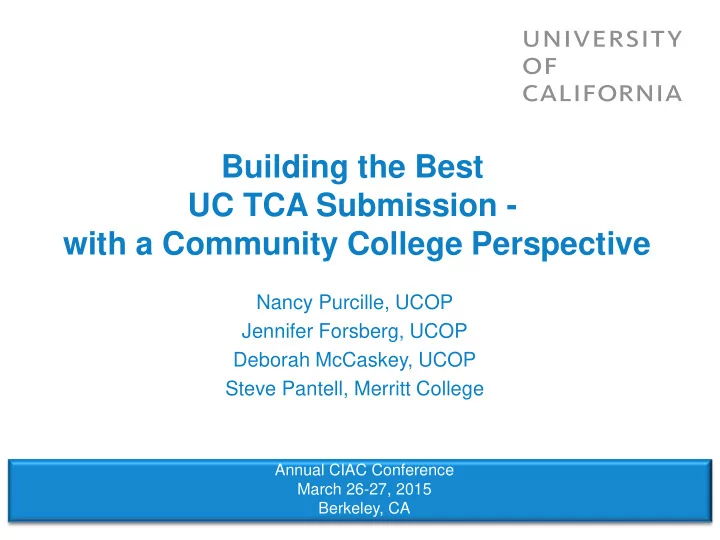

Building the Best UC TCA Submission - with a Community College Perspective Nancy Purcille, UCOP Jennifer Forsberg, UCOP Deborah McCaskey, UCOP Steve Pantell, Merritt College Annual CIAC Conference March 26-27, 2015 Berkeley, CA
The TCA Transfer course agreements (TCAs) are the baseline for establishing transferability of CCC courses to UC. There are about 48,000 community college courses approved for UC TCAs on ASSIST. CCCs are assigned a month – June, July or August – during which they submit courses for review. In 2014, more than 3,600 courses were submitted and reviewed for the TCA; approximately 90% were approved. The following sample course outline illustrates what we look for during review. Annual CIAC Conference, March 26-27, 2015 2
Your Outline: First Page College Name: California Community College Course Name: BIO 310 Title: Introduction to Biology Units: 5 Same As: Current UC Transferable: N Requested UC TCA Action: Add Is the data entry of this course outline complete? Y Is this course repeatable? N Is this an honors course? N Lecture hours per term: 54.00 Lab hours per term: 108.00 Date of campus approval of course outline: May 15 2014 Annual CIAC Conference, March 26-27, 2015 3
Your Outline: Course Description Course Description: This course, intended for science majors, introduces the ecological and evolutionary processes that shape biodiversity, relating the patterns of biodiversity to small and large scale environmental effects. The diversity of life on Earth (including animals, plants, fungi, protists, and additional unicellular organisms) is covered. Overarching themes include evolutionary mechanisms, phylogenetic analysis, interactions of organisms with the environment, and global processes and patterns. Not open for credit to students who have completed BIOL 410 and BIOL 420 with a grade of C or better. Field trips may be required. Prerequisites: BIO 300 with a grade of "C" or better Corequisites: None. Advisories: Eligible for ENG 1A Annual CIAC Conference, March 26-27, 2015 4
Your Outline: Course Objectives Course Objectives: Upon completion of this course, the student will be able to: • define and give examples of the levels of organization seen in living things from cells, organs, tissues, and tissue systems to ecosystems. • explain evolutionary mechanisms for both macroevolution and microevolution and how they relate to the diversity of life – and apply them to specific examples. • investigate various mechanisms used by organisms to produce, store, and use energy. • describe processes involved in embryologic development of major taxa with the focus on how these life cycles relate to evolutionary mechanisms and ecological principles. • identify, compare, and contrast representative reproductive strategies seen in major phyla; detail how these relate to evolutionary mechanisms and ecological principles. Annual CIAC Conference, March 26-27, 2015 5
Your Outline: Course Content Course Content: 3 hours: Evolutionary Theory, Mechanisms, and Evidence: Introduction to phylogenetics. 5 hours: Evolutionary Theory, Mechanisms, and Evidence: Species concepts, mechanisms of speciation, mechanisms of macroevolution and microevolution. 3 hours: Phylogeny of Life on Earth: History of life, significant events, major lineages. Bacteria, Archaea and the root of the tree of life. Origin and diversification of eukaryotes. 2.5 hours: Evolutionary Theory, Mechanisms, and Evidence: Animal evolution and body plans. 2 hours: Phylogeny of Life on Earth: Major invertebrate animal groups. Evolution and diversity. Annual CIAC Conference, March 26-27, 2015 6
Your Outline: Lab Content Lab Content: 3 hours: Evolutionary Theory, Mechanisms, and Evidence: Build and interpret phylogenetic trees. 6 hours: Evolutionary Theory, Mechanisms, and Evidence: Create a simulation of migration, mutation, genetic drift, and natural selection to analyze factors that affect allele frequency. 2 hours: Phylogeny of Life on Earth: Compare and contrast major taxonomic groups of organisms on display to elucidate significant adaptations in the history of life on Earth… Annual CIAC Conference, March 26-27, 2015 7
Your Outline: Instruction, Assignments, Evaluation Methods of Instruction: Lecture, discussion, group presentations, labs, experiments, data analysis, peer instruction, group work, and field trips Out-of-Class Assignments: Example #1: Prepare a 10-minute oral presentation, using visual aids, on a diversity, evolutionary or ecology topic relevant to the course. Describe relevant physiological, biochemical, environmental, economic, medical, and other aspects of the organism or topic being covered. Include arguments for or against data presented. Submit a 3-page written report. Example #2: Create and interpret cladograms to explain evolutionary and ecological relationships. Methods of Evaluation: Exams, quizzes, homework, lab reports, lab exams, field trip reports, oral presentations, written reports, and participation Annual CIAC Conference, March 26-27, 2015 8
Your Outline: Required Reading Examples of Appropriate Texts or Other Required Reading: Title: Campbell Biology Author: Reece, J., et al. Date: 01/01/2014 Title: A Photographic Atlas for the Biology Laboratory Author: Rushforth, S., et al. Date: 01/01/2009 Title: Biology: Organisms and Adaptations Author: Noyd, R., Krueger, J., & Hill, K. Date: 01/01/2014 Other Appropriate Reading: Faculty-generated lab manual Other Outline Information: Annual CIAC Conference, March 26-27, 2015 9
Questions? Nancy Purcille, Transfer Articulation Coordinator, UCOP nancy.purcille@ucop.edu 510-987-9569 Jennifer Forsberg, Articulation Analyst, UCOP jennifer.forsberg@ucop.edu 510-987-0907 Deborah McCaskey, Articulation Analyst, UCOP deborah.mccaskey@ucop.edu 510-987-0566 ASSIST Coordination Site 949-824-4385 Annual CIAC Conference, March 26-27, 2015 10
Resources UCOP Transfer Articulation: http://www.ucop.edu/transfer-articulation/index.html UC TCA & IGETC Agreements: www.assist.org OSCAR – Online Services for Curriculum and Articulation Review: http://info.assist.org/oscar.html 2014 Counselor Conference Information: http://admission.universityofcalifornia.edu/counselors/downloadable-guides/index.html 2015 Ensuring Transfer Success (ETS) Information: http://admission.universityofcalifornia.edu/counselors/news-events/ets/index.html UC catalogs: http://www.universityofcalifornia.edu/campuses/welcome.html Articulation Handbook: http://ciac.csusb.edu/ciac/handbook.html CIAC mentors: http://ciac.csusb.edu/mentor.html Transfer Prep Paths: http://admission.universityofcalifornia.edu/transfer/preparation-paths/ UC Transfer Admission Planner: http://admission.universityofcalifornia.edu/transfer/transfer-admission-planner/ Annual CIAC Conference, March 26-27, 2015 11
Recommend
More recommend